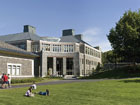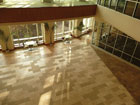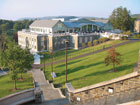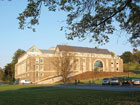
Photo by Anton Grassl/ESTO
Colgate University recently underwent construction of a new science center and extensive renovation of its library - both of which feature stone on the exterior to complement the campus’ other stone buildings. The entire exterior of the new science center utilizes New York Bluestone from Finger Lakes Stone Co., Inc. of Ithaca, NY.
Colgate University recently underwent construction of a new science center and extensive renovation of its library - both of which feature stone on the exterior to complement the campus’ other stone buildings. The entire exterior of the new science center utilizes New York Bluestone from Finger Lakes Stone Co., Inc. of Ithaca, NY.
Founded in 1819, Colgate University had its first building, West Hall, built by students and faculty using stone from the university’s own rock quarry. Today, two centuries later, its latest projects echo similar material selections as the university’s original structure. The campus, which is in Hamilton, NY, recently underwent construction of a new science center and extensive rebuilding and renovation of its library. Both structures pay tribute to the surrounding campus by using natural materials to complement the other stone buildings.
“Colgate is almost 100% stone, in all of the buildings from the very beginning,” said Alexander Howe, AIA, Principal for Design at Shepley Bulfinch Richardson & Abbott in Boston, MA, which served as the Design Architect for the project. “It was very clear that they were going to build [and renovate] both of these buildings with stone material.”

Photos by Anton Grassl/ESTO
The Bluestone pieces used for the exterior facade of the science center were laid in an ashlar pattern - with sizes ranging from no more than 27 inches long or 14 inches wide.
The Bluestone pieces used for the exterior facade of the science center were laid in an ashlar pattern - with sizes ranging from no more than 27 inches long or 14 inches wide.
Howe explained that each section of the campus, which is sited on a hillside, follows a variation of color when it comes to the materials that make up the structures. For instance, the center of the campus ranges from gray to blue to brown, the chapel is a bluish gray and then the later buildings move toward purple shades. “Colgate is like an acropolis,” said Howe. “The campus covers almost 10 stories from bottom to top. It’s built on this great hillside.”
While the library is at the bottom of the hill near the “bluish/brown” area of the campus, the science center is fitted between several existing buildings in the “purple” section. “I wanted the [science center and library] to be somewhat differentiated because they are in different parts of campus,” said Howe.

In total, the stonework on the 125,700-square-foot science center took around eight months to complete.
Howe explained that the tones for the new science center were selected, in part, to relate to the neighboring structures. “One of the buildings next to the science center has a beautiful stone with a very rich purple variation to it,” he said. “I wanted to make sure we picked that up.”
To achieve the desired design effect, the entire exterior of new science center utilizes New York Bluestone from Finger Lakes Stone Co., Inc. of Ithaca, NY, in an ashlar pattern - with pieces ranging from no more than 27 inches long or 14 inches wide.

Photo by Daniel Salive
Inside the science center, the atrium features Emperador Light, Bateig Blanca and Crema Ella fossilized limestone for the flooring. The pieces, sized in 12 x 24 x ½ inches were supplied by Stone Source of Boston, MA.
Inside the science center, the atrium features Emperador Light, Bateig Blanca and Crema Ella fossilized limestone for the flooring. The pieces, sized in 12 x 24 x ½ inches were supplied by Stone Source of Boston, MA.
Additionally, a geology museum in the science building contains the same fossilized limestone found in the atrium.

Photos by Kevin Triplett
The first four floors of the library’s exterior are clad in Llenroc Bluestone, also from Finger Lakes Stone Co. A fifth floor with a bridge was added to the original library to make it more accessible to students since the library sits at the bottom of the campus’ hill.
The first four floors of the library’s exterior are clad in Llenroc Bluestone, also from Finger Lakes Stone Co. A fifth floor with a bridge was added to the original library to make it more accessible to students since the library sits at the bottom of the campus’ hill.
For the library, Howe explained that the design team tried to differentiate the size of stone from the science center. “We wanted the library to have a slightly smaller size in terms of pieces,” he said. “There are much larger pieces on the science building.”
The first four floors of the exterior are built of Llenroc Bluestone, also from Finger Lakes Stone Co., in a handset ashlar pattern, with pieces sized not longer than 24 inches and not over 10 inches high. The fifth floor above that was done in a precast.

The Llenroc Bluestone is handset in an ashlar pattern, with pieces sized not longer than 24 inches and not over 10 inches high.
“We went through many mock-ups,” he continued. “Not an extraordinary amount, but we had at least five for the library to really get the palette just right. The sizing - to get differentiated sizes of pieces - was also very important.”
The design called for the addition of a fifth floor to the library. Howe explained that because of its location, the top of the building could be easily viewed from above. “The library is on the lower part of the campus’ slope,” said Howe. “All of the buildings look down on it, so we needed to make the top look beautiful.”
Additionally, since the library is near the bottom of the campus hill, the top floor has an entrance to make the library more accessible. “We added an entry at the top, so the kids didn’t have to go to the middle of the five floors to get in,” the architect said. “Most of the terracing at the top floor is accessible, but you can go over a bridge to enter the top.”

Photo by Anton Grassl/ESTO
“The addition and the renovation to the existing library was very difficult,” said Alexander Howe, AIA, Principal for Design at Shepley Bulfinch Richardson & Abbott in Boston, MA, which served as the Design Architect for the project. “Parts of the original library were built in the 1960s and the 1980s, and they were very different in design and character. Our concept was to add to the existing structure and join all parts in a new stone skin.”
“The addition and the renovation to the existing library was very difficult,” said Alexander Howe, AIA, Principal for Design at Shepley Bulfinch Richardson & Abbott in Boston, MA, which served as the Design Architect for the project. “Parts of the original library were built in the 1960s and the 1980s, and they were very different in design and character. Our concept was to add to the existing structure and join all parts in a new stone skin.”
For both of the buildings, many of the obstacles came in the detailing around the windows, Howe explained. “In the science center, some of the windows are very big, almost double height, and there’s a curtainwall between the stone piers,” he continued. “ I often prefer to batter them to not have a vertical stone, but to have it slightly angled to the ground. It gives a feeling of stability and permanence, as if the stone is rising out of the ground. To get that right, this adds complexity for the stonemason. It was a very good installation. The construction was fairly standard with regard to review and inspection. Nothing out of the ordinary, and the masons were excellent.”
In total, the stonework on the 125,700-square-foot science center took around eight months to install, while the stonework on the 153,000-square-foot library took approximately 10 months to complete. “The projects have been complete now for about a year,” said Howe. “The University loves them.”
Sidebar: Colgate University New Science Center Construction and Library Renovation
Hamilton, NYDesign Architect: Shepley Bulfinch Richardson & Abbott, Boston, MA
Executive Architect (library): Kendall Heaton Associates, Houston, TX
Stone Suppliers: Finger Lakes Stone Co., Inc., Ithaca, NY (Bluestone); Stone Source, Boston, MA (science center interior materials)
